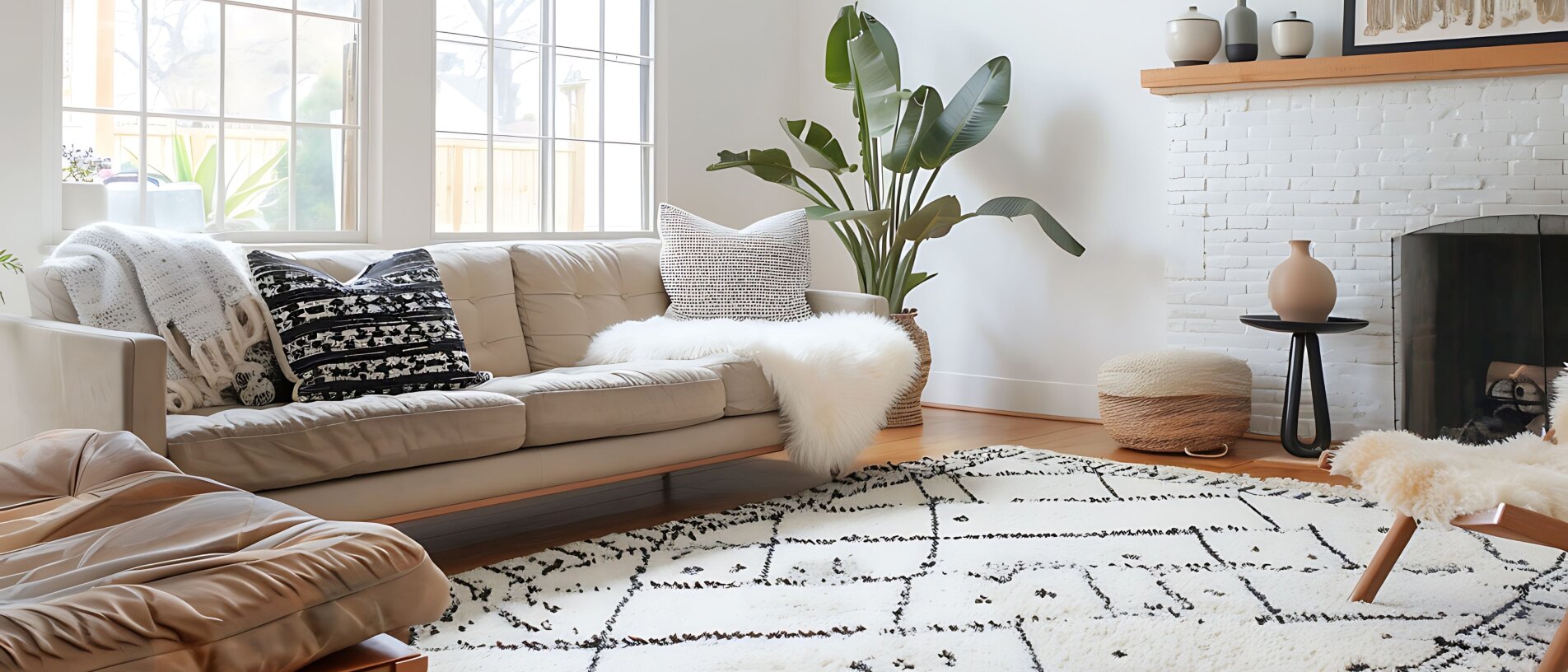You're on the list
By signing up, you agree to receive email marketing.

Area rugs offer a distinct decor advantage: They are portable, versatile, and allow you to experiment with design and color. It’s tempting to choose a beautiful rug online and just hope it fits your room, but asking a few questions first can maximize the beauty of your space.
Color is a make-or-break when it comes to rug buying. Here’s what to keep in mind for the perfect piece.
When choosing a rug color, think about the inevitable spills and dirt from traffic. Darker colored rugs can mask the stains from turned-over juice boxes or tipped glasses of wine. The same is true for pet hair and grime from muddy boots.
Take a minute to consider how often you can clean the rug and how pristine you want to keep it. Lighter colors are just fine if you’re looking to style a showroom or one that’s regularly maintained.
If you want a lighter rug shade but intend your rug to go in a mud room or kids' play area, think about a subtle pattern instead of plain white. A textured colored pattern can make any imperfections harder to see until you get a chance to attend to them.
Natural fiber rugs come in a range of colors that make them flexible for many decors. But if you want to maintain a natural feel, you might opt for a neutral tone that goes with this material.
Bamboo, seagrass, hemp, and sisal rugs offer durability, but synthetic fibers such as nylon and polyester can keep the color longer as they tend to be fade-resistant. A flat weave, low-pile rug might be especially easy to take care of in high-traffic areas.
If you want to increase the openness of a room, consider a lighter rug color. This can work especially well in a room that gets lots of natural light, such as from large windows or an upstairs balcony.
Rug patterns can also affect how large a room feels. If your pattern is too busy or your color too bright, it can make the room seem more compact. On the flipside, a bold pattern or color can make the rug a focal point of the room, which can be a great look for a big space.
Each room invokes a certain feel which can impact your daily comfort. Your rug color can advance the mood you want to create. The rug is the centerpiece of the space, so take some time to reflect upon how color can contribute to the feeling when someone enters the room.
A breakfast nook in a brightly lit corner of the kitchen might do well with a white, yellow, or other spring-colored rug. A meditation room is a calming space, so you might choose blues, greens, or softer tones. Bright oranges, reds, and yellows are excellent colors for rugs in active spaces like kids' playrooms.
It’s often a good idea to aim for balance when it comes to your rugs and mixing patterns and colors. Think about the rest of the room’s furniture and decor. If it’s mostly solid color, you might want to experiment with a bold pattern for the rug.
You also don’t have to choose your patterns randomly — consider matching the colors in your rug pattern to the sofa, drapes, and bedspread. Let’s say you have a navy blue sofa, white bedspread, and gray drapes. A simple patterned rug in blue and gray might do well to pull the room together.
In an eclectic room with varying decor, you might want to achieve balance with a solid neutral-colored rug. Don’t forget the accent colors in the room, such as lamps, flower vases, and artwork. Sometimes a solid rug color that’s the same as the accent colors can make the room feel complete.
Unless you’re doing a complete renovation, you’ll have to consider the existing paint color of your walls. If your walls are a neutral white there’s greater attention to the floor and the rug. If there’s an accent wall or a bold color on all walls, the rug should fit in neatly with that aesthetic.
An accent wall is an excellent color match for your rug. If you have one wall that’s solid forest green, a rug in a complementary solid tone or subtle pattern is often a safe choice. That’s assuming, of course, that the other walls are neutral so there’s no chance of a clash with the rug.
If you’re finding it hard to get the right fit between your rugs and walls, consider small tweaks to your existing decor. That might mean a well-placed piece of artwork or removable patterned paper to make the wall pop in conjunction with the rug.
By choosing an area rug instead of wall-to-wall carpeting, you have two colors on the floor by default: the floor and the rug. Think about what works with your floor, whether it’s hardwood, laminate, or exposed wood in the case of a back deck or cottage space.
In most cases, the floor is neutral, but it can also have a distinct aesthetic. An indoor floor space that’s meant to resemble natural wood brings a naturalistic, down-to-earth vibe. Working with a rug that’s also made of a neutral-toned, natural fiber might be a perfect match. A bold, colored rug might create just the mood for a floor that’s darker with an industrial or metal feel.
The right rug for your room depends on the colors you’ve already chosen to make the perfect space. As you switch up your room decors, feel free to rotate your rugs to fit your current look. Rugs can keep you in step with current trends and your current aesthetic preferences.
You're on the list
By signing up, you agree to receive email marketing.